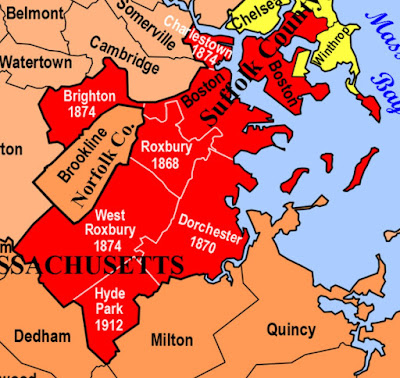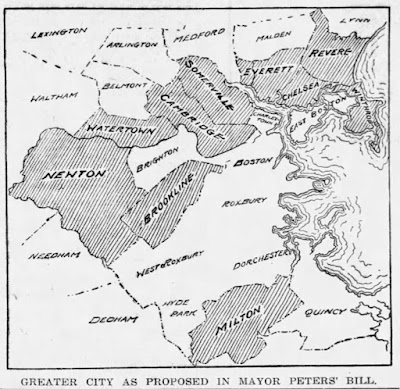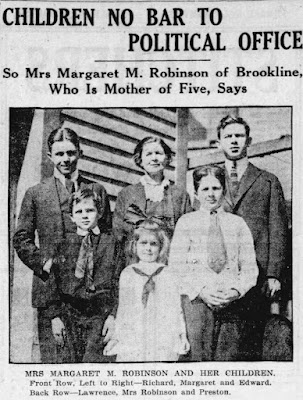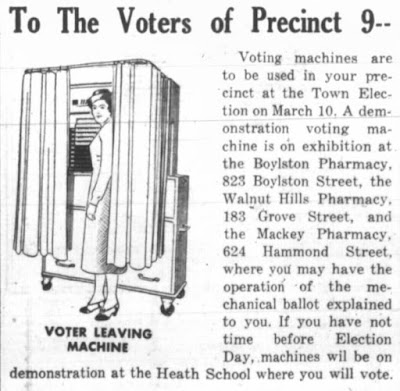 |
| March 18, 1919 |
March 13,1895 - Establishment of Brookline Education Society
March 18,1919 - Town Meeting votes against annexation
March 15,1921 - First four women take seats in Town Meeting
March 18,1941 - BK votes to use voting machines (a Massachusetts first)
March 13, 1895
Establishment of Brookline Education Society
The Brookline Education Society, an organization created "to bring the school and the home into closer sympathy," was formed in a meeting at the High Street home of Annie E. Crane. "Nothing could be more promising to the cause of education," reporting the organization in its first annual report, "than frequent mutual conferences between teachers and parents."
By November, the Society had more than 400 members and had established a lecture series on education that brought in speakers from Harvard, Yale, Dartmouth, and other educational and civic institutions.
 |
| This article about Education Society's inaugural lecture series appeared in the Boston Globe on November 15, 1895 |
In 1915, the organization changed its name to the Brookline Civic Society, reflecting a focus on broader civic concerns than just education. The Civic Society disbanded in 1926.
March 18, 1919
Town Meeting votes against annexation
Boston had grown dramatically between the Civil War and World War I, annexing the neighboring towns of Roxbury, Dorchester, Charlestown, Brighton, West Roxbury, and Hyde Park. (See the map above.) But Brookline resisted.
In 1873, Brighton (northwest of Brookline) and West Roxbury (southwest) voted to join the big city, as did Charlestown, following earlier votes by Roxbury (1868) and Dorchester (1870). The new annexations took effect in 1874. (Brookline lost its Charles River waterfront, given to Boston to connect it with the newly incorporated Brighton district.) But Brookline overwhelmingly rejected annexation, by a vote of 707 to 299.
Pro-annexation forces in Brookline and in Boston continued to advocate for the town's incorporation into the bigger city. The last gasp came in 1919, seven years after Hyde Park became part of Boston. A bill introduced in the legislature by Boston Mayor Andrew Peters would annex Brookline and nine other communities. Town Meeting voted 198-1 to oppose the plan. Other targeted communities also objected and the bill was withdrawn a week later.
 |
| Map showing the annexations proposed under the Peters Bill. Boston Globe, January 10, 1919 |
March 15,1921
First four women take seats in Town Meeting
Brookline's Town Meeting met with women members for the first time following the first town election after women gained the right to vote. The women were Margaret Robinson, Sybil Holmes, Helen Whitington, and May Johnston.
Robinson was asked if a woman with five children could find time for politics and government.
"I certainly do," she replied [as reported in the Boston Globe]. "I know men with families as large as mine who find the time and don't neglect the families. Why can't women do it?"
 |
| Margaret Robinson and her five children, as shown in the Boston Globe, March 14, 1921 |
Robinson, a resident of The Point neighborhood, continued to serve as a Town Meeting Member until her death in 1935. She also served for six years on the town's School Committee. Four years after her death, the new playground in the neighborhood, built on the site of the former car barn lot for the Boston Elevated Railway Company in the neighborhood, was named after her.
March 18,1941
Brookline votes to use voting machines (a Massachusetts first)
Town Meeting approved the allocation of funds to purchase a first batch of voting machines for use in elections in the town. Brookline thus became the first municipality in Massachusetts to approve a move from paper to machine balloting.
 |
| This example of a 1940s voting machine was used to instruct Brookline voters how to use the new form of balloting. (Photo courtesy of Town Clerk's office) |
Voting machines manufactured by the Automatic Voting Machine Corporation had been tested the year before, first in a Brookline High School election and later in one precinct in a town election. The decision by Town Meeting assured that the machines would be gradually rolled out townwide.
Demonstrations showing how to use the new machines were held in various places, beginning with Precinct 9 in South Brookline, as the new voting system was put in place.
 |
| Advertisement in the Brookline Citizen ahead of the March 1942 town election |

No comments:
Post a Comment